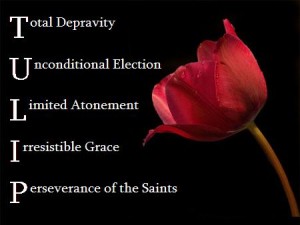 This short article by Justin Taylor made me laugh. It contains some helpful and useful material, but I just saw the funny side of the historic TULIP acrostic suffering a massive regressive evolution of sorts and becoming WUPSI:
This short article by Justin Taylor made me laugh. It contains some helpful and useful material, but I just saw the funny side of the historic TULIP acrostic suffering a massive regressive evolution of sorts and becoming WUPSI:
Despite the number in common, the “five points of Calvinism” (TULIP) don’t come from the Decision of the Synod of Dordt on the Five Main Points of Doctrine in Dispute in the Netherlands (more popularly known as simply the Synod of Dort, 1618-1619).
The first documented use of the TULIP acronym for the doctrines of grace can be found here. Writing in 1913, the author recalls a popular lecture from Dr. Cleland B. McAfee in 1905. Dr. McAfee was the pastor of Lafayette Avenue Church in Brooklyn at the time. (In 1913 he joined the faculty at McCormick Theological Seminary in Chicago.)
Dr. McAfee essentially gave the acronym as we know it today, except that “U” stood for “universal sovereignty” in his talk, whereas it’s known today as “unconditional election.”
Total depravity
Universal sovereignty
Limited atonement
Irresistible grace
Perseverance of the saints
It has become popular of later to retain the content of the “five points” but to tweak the terminology and even rearrange them for better communication. One of the more creative ones is found in Timothy George’s Amazing Grace: God’s Pursuit, Our Response:
Radical depravity
Overcoming grace
Sovereign election
Eternal life
Singular redemption
And it’s also hard not to admire the gospel- and grace-based approach of Roger Nicole:
Grace
Obligatory grace
Sovereign grace
Provision-making grace
Effectual grace
Lasting grace
I believe that the five points—rightly understood—are gloriously true and can be clearly demonstrated exegetically—but I still had to smile at this comment in Greg Forster’s forthcoming book The Joy of Calvinism: Knowing God’s Personal, Unconditional, Irresistible, Unbreakable Love (Crossway, coming in February 2012):
It sometimes feels like Calvinists first invoke the five points, then apologize for invoking the five points, then explain how the five points don’t really mean what they seem to mean and aren’t really saying what they seem to be saying. This can’t possibly be the best way to introduce people to what we believe.
Forster’s own alternative brings out the trinitarian nature and redemptive progression of this teaching:
State of man before salvation: wholly defiled
Work of the Father in salvation: unconditional choice
Work of the Son in salvation: personal salvation
Work of the Spirit in salvation: supernatural transformation
State of man after salvation: in faith, perseverance
Tongue in cheek, Forster writes:
This gives us the handy mnemonic WUPSI, pronounced “whoopsie”—as in, “whoopsie, we just realized that TULIP is giving everyone heinously false ideas of what Calvinism is all about.” Perhaps it’s not as memorable as TULIP, but it has other virtues to make up for that.
For more on these issues, see Kenneth Stewart’s third chapter in Ten Myths about Calvinism: Recovering the Breadth of the Reformed Tradition.
